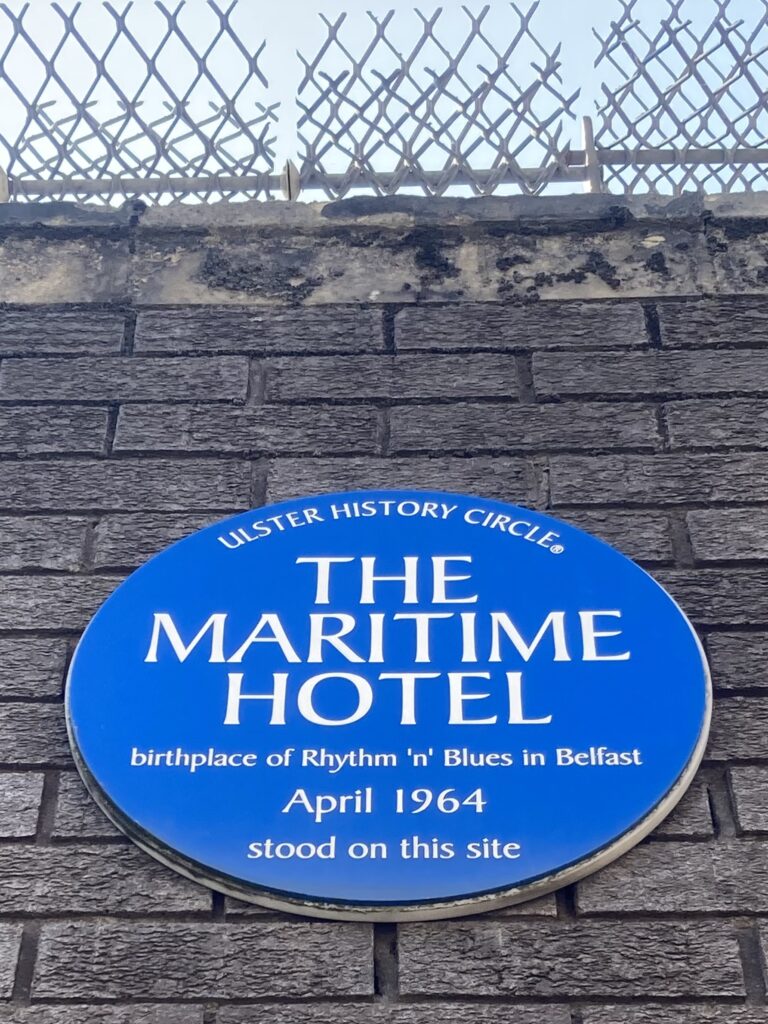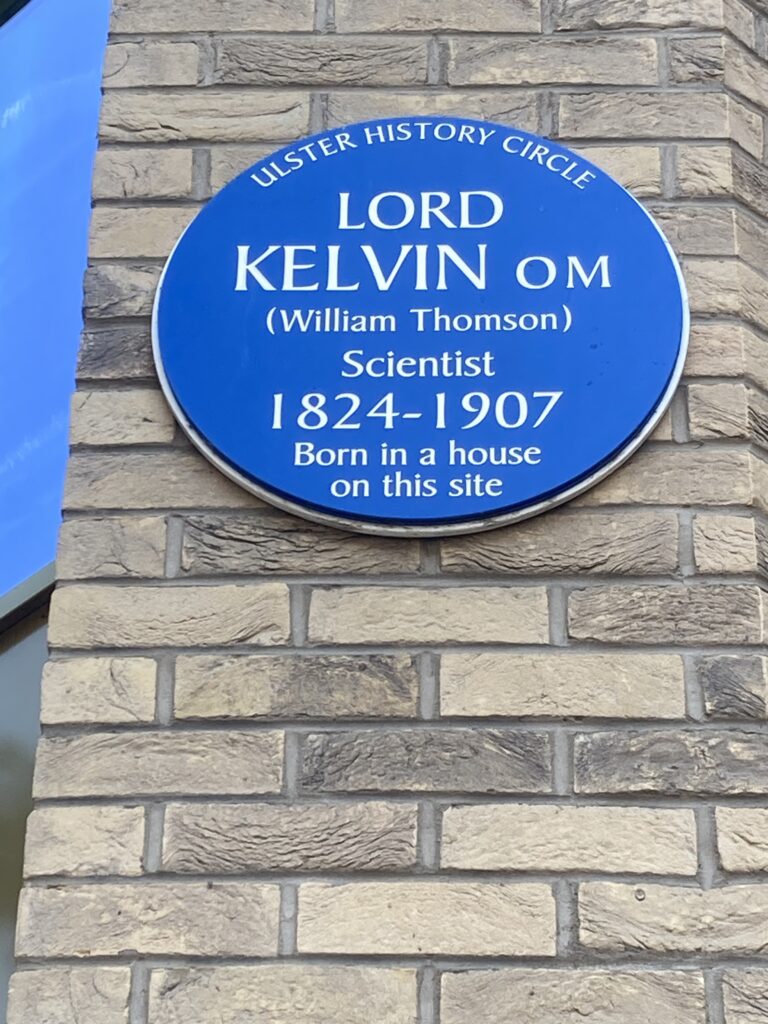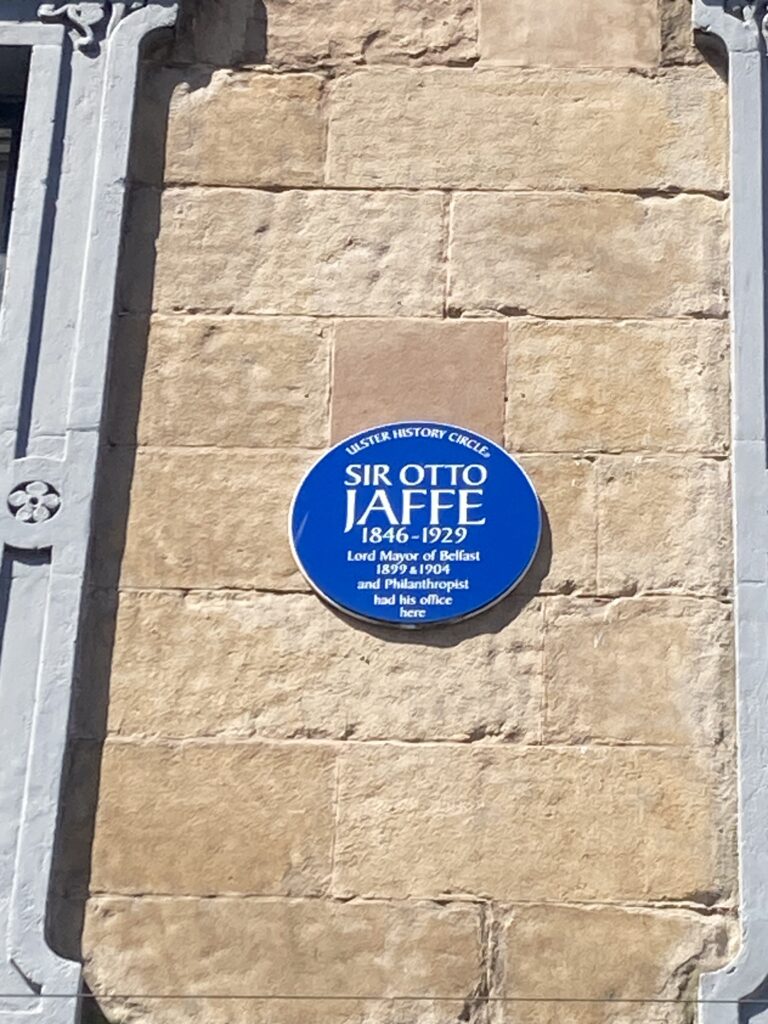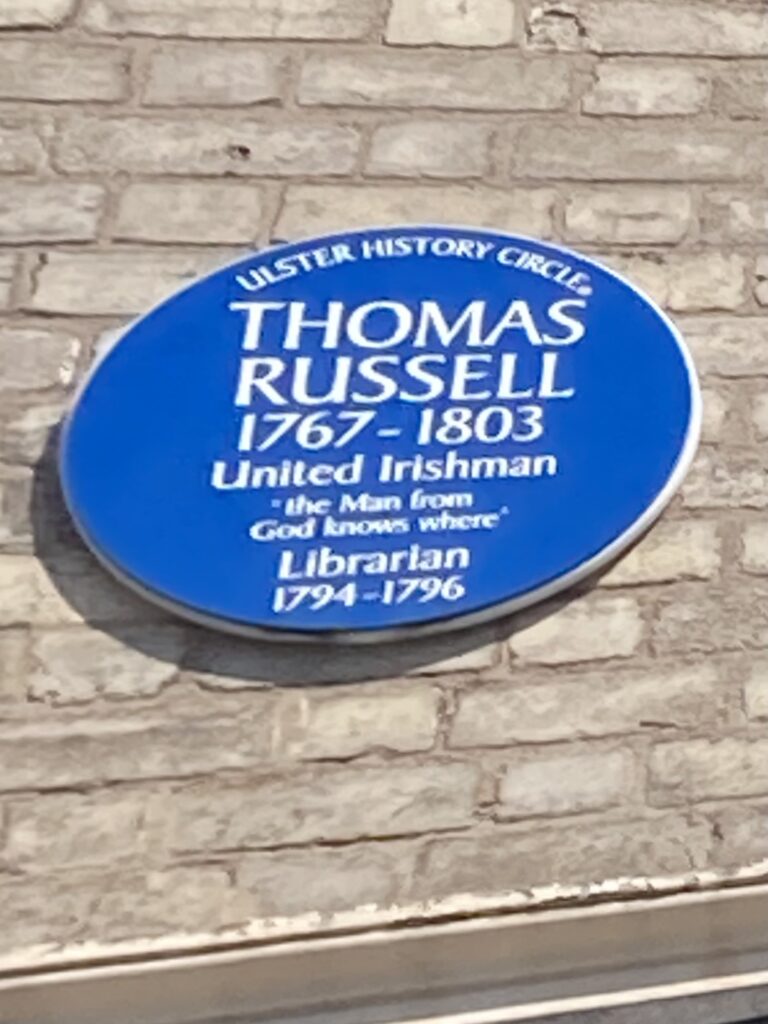Belfast Blue Plaques Walking Tour
#DestinationScotland

The next morning at precisely 11.00am, as Belfast’s ancient Linen Hall Library clock was striking in the reception area. I met my guide again.
He had been there the previous day when I went to enquire about my tickets. I mentioned that I’d come in to double check I’d been booked on the tour due to the issue with the website, and mentioned that I would not be surprised if I was the only one due to the glitch.
These words proved prophetic, I was indeed treated to a one-to-one tour of about 20 ‘Blue Plaques’ given by historian John Bradbury, author of ‘Celebrated Citizens of Belfast.’
There had been quite an exchange of emails on the issue, and Mr. Bradbury himself had taken the matter up with the office.
I really hope that while the old institution might be very good at the traditional skills of running the library and promoting the local culture and rich history, it will overcome any other teething problems while transitioning from promoting it’s activities via long established channels to new media.
Anyway, the pair of us left the bustling building behind and stepped onto the baking Belfast pavements.

Indeed our first stop was at Barney Hughes, the baker’s Blue Plaque. The inventor of the ‘Belfast Bap’. Although he became rich and famous in the city, young Barney was of humble origins he began to work as a baker’s boy in Armagh at 12 years old. In the 1820’s he moved to Belfast and began working his way up the career ladder to become a manager, and soon borrowing money to open his own bakery in Donegall Street. The budding entrepreneur was keen to try out new food processing methods and machinery and soon he was able to expand his business opening new premises in Donegall Square, the Railway Bakery.
The new methods, and his innovate business model, taking control of the whole supply of ingredients and distribution of baked goods meant Barney Hughes could sell much more cheaply than his competitors. He did not take advantage of his position, but ensured the best of working environments for the staff. He developed the Belfast Bap so that even during the Famine Years the poorest of his countrymen could still afford their daily bread.
Text: BelfastEntries.com
On the outside of a school wall, on the site of the former Maritime Hotel, the birthplace not of one of Belfast’s Celebrated Citizens but of Rhythm ‘n’ Blues Music in Belfast.
In the early 1960s, Belfast nightlife largely consisted of a number of licensed cabaret clubs with genteel pianists and singers and an array of sedate ballrooms where smart-suited showbands pounded out cover versions of the latest top ten hits.But in April 1964, in the aftermath of the popular music earthquake triggered by the Beatles and the Rolling Stones, a spartan seamans’ hostel in College Square North, Belfast, which had formerly been a Royal Irish Constabulary police station, was transformed into the Club Rado and a new rhythm ‘n’ blues movement in the city was inaugurated.
A group called Them, sporting long, long hair and unkempt casual clothing, was in the vanguard of this new musical phenomenon and within weeks of its opening, long queues of fashionably dressed teenagers formed outside to ensure they got into the 200 capacity hall to enjoy the throbbing music.
In no time, the Maritime, as it was more widely called, had earned a reputation on a par with the famous Cavern Club in Liverpool, where the Mersey sound was incubated, for highlighting a new generation of exotic musicians who were inspired by the traditional American rhythm ‘n’ blues tunes but who gave the music their own twist laying the foundations for what would years later evolve as Celtic rock. Other of the Maritime alumni are still active musically playing the blues around various venues in Belfast.
See full text: ulsterhistorycircle.org.uk/


William Thomson was the son of the then Headmaster of The Royal Belfast Academical Institution, who was appointed Professor of Mathematics at Glasgow University in 1832. William himself entered that university as a student at the early age of eleven and went on to Peterhouse College, Cambridge, returning to Glasgow as Professor of Natural History at the age of 22. He held this post until his retirement in 1899, a period of fifty-three years. He was knighted in 1866, and created Baron Kelvin of Largs in 1892.
His main scientific discoveries were in the field of mechanical energy and heat; the absolute scale of temperature, with its zero at minus 273 degrees Centigrade, is named after him. He also patented many practical inventions, including a compass that was adopted by the Royal Navy and a mirror galvanometer that was used in the first transatlantic cable, from Valentia Island to Newfoundland; Thomson himself was on board Brunel’s Great Eastern, which laid the cable. These patents made him a wealthy man. All in all, he published in his lifetime more than three hundred papers on various aspects of physical science. Lord Kelvin died at his house near Largs, and was buried in Westminster Abbey.
This plaque hangs at the site of his birth house at 21-25 College Square East (now Kelvin Building). This also became the site of Belfast’s first cinema, named appropriately enough the Kelvin. His statue stands near the Stranmillis entrance of Botanic Gardens.
See full text on ulsterhistorycircle.org.uk.
Otto Jaffe was born in Hamburg in 1846, came to Belfast at the age of 6 and at 16 he entered the family business, Jaffe Brothers Linen Merchants, also known as Strand Spinning. They provided work for about 350 local people, rising to 650 in 1914 when the company expanded to make munitions. Otto was educated in Belfast, Hamburg, and Switzerland. After carrying on business in New York from 1865 to 1877, he became chief director of the Belfast firm.
Sir Otto was well known throughout his public life in Belfast for his generosity of both time and money. During his first term as Lord Mayor he and the Lady Mayoress raised £10,000 for the dependants of soldiers and sailors serving in the Boer War. He contributed £1,000 to the original building fund for the Royal Victoria Hospital where he was Governor,
In 1905 Sir Otto gave £4,000 to the fund for better equipment for Queen’s College (now university). He was an active member of the committee that got the Public Libraries Act extended to Belfast, leading to the first free library being established.
As President of the Belfast congregation he made a huge contribution to the consolidation of the province’s Jewish population, providing most of the funds for the new synagogue in Annesley Street, Carlisle Circus, in 1904. He had a deep interest in education and funded the Jaffe Public Elementary School at the corner of Cliftonville and Antrim Road in 1907, which, by his stipulation, was not exclusively Jewish, either in its management, staffing or pupils. He was a justice of the peace, a member of the Harbour Board and the German Consul.
See full text on ulsterhistorycircle.org.uk.

Otto Jaffe was born in Hamburg in 1846, came to Belfast at the age of 6 and at 16 he entered the family business, Jaffe Brothers Linen Merchants, also known as Strand Spinning. They provided work for about 350 local people, rising to 650 in 1914 when the company expanded to make munitions. Otto was educated in Belfast, Hamburg, and Switzerland. After carrying on business in New York from 1865 to 1877, he became chief director of the Belfast firm.
Sir Otto was well known throughout his public life in Belfast for his generosity of both time and money. During his first term as Lord Mayor he and the Lady Mayoress raised £10,000 for the dependants of soldiers and sailors serving in the Boer War. He contributed £1,000 to the original building fund for the Royal Victoria Hospital where he was Governor,
In 1905 Sir Otto gave £4,000 to the fund for better equipment for Queen’s College (now university). He was an active member of the committee that got the Public Libraries Act extended to Belfast, leading to the first free library being established.
As President of the Belfast congregation he made a huge contribution to the consolidation of the province’s Jewish population, providing most of the funds for the new synagogue in Annesley Street, Carlisle Circus, in 1904. He had a deep interest in education and funded the Jaffe Public Elementary School at the corner of Cliftonville and Antrim Road in 1907, which, by his stipulation, was not exclusively Jewish, either in its management, staffing or pupils. He was a justice of the peace, a member of the Harbour Board and the German Consul.
See full text on ulsterhistorycircle.org.uk.

Terence Wilfred Hooley (born 23 December 1948) is a prominent figure in the Belfast punk scene and founder of the Good Vibrations record shop and label.
The shop started off in Great Victoria Street in 1977 and reopened in several other locations such as Howard Street, Smithfield and Winetavern Street and then over Cafe Wah in North Street. It became a mecca for music lovers from all over Northern Ireland and beyond.
Wikipedia
Earlier this summer Terri Hooley was admitted to the City Hospital in Belfast on Wednesday at 11am. The doctor told him that he needed urgent treatment and an extended stay in the ward. By 8pm, Terri was at the Strand Arts Centre, watching the 10th anniversary showing of the film Good Vibrations.
Belfast Telegraph


Thomas Russell (“the Man from God knows where”) was among the founders and a leading member of the United Irishmen. He was born in Drumahane, County Cork on 21 November 1767 and, following his family tradition of military service, joined the army in 1973 and was posted to India. He returned to Ireland in 1776, on half pay and continued his studies in science, philosophy and politics. In July 1790 he met Theobald Wolfe Tone in the visitor’s gallery in the Irish House of Commons and they became firm friends.
From his position as librarian to the Society for the Promotion of Knowledge (later to become the Linen Hall Library), to which he was appointed in February 1794, Russell took an active part in organising the United Irishmen and by 1796 he was their commander in County Down. He was arrested in that year and lodged in Dublin’s Newgate prison and as a consequence he took no part in the Rising of 1798. In March 1799 he and the other state prisoners were transferred to Fort George in Scotland, an extensive fortress some miles north of Inverness. During his imprisonment he was never charged with any crime, being, in effect, a political prisoner. He was released in June 1802 and transported to Hamburg.
Russell was transferred to Downpatrick Gaol and tried for high treason with three local men, James Drake, James Corry and Michael Maguire. Found guilty on the evidence of many local witnesses, he was hanged and then beheaded at the gate of the gaol on 21 October 1803, one month short of his 37th birthday.
Following his execution he was buried in Down Parish Churchyard where Mary Ann McCracken, sister of Henry Joy McCracken (executed in 1798) and friend of Russell, arranged for a simple memorial that still remains. All it says is “The Grave of Russell”
See full text on ulsterhistorycircle.org.uk.
Leave a Reply